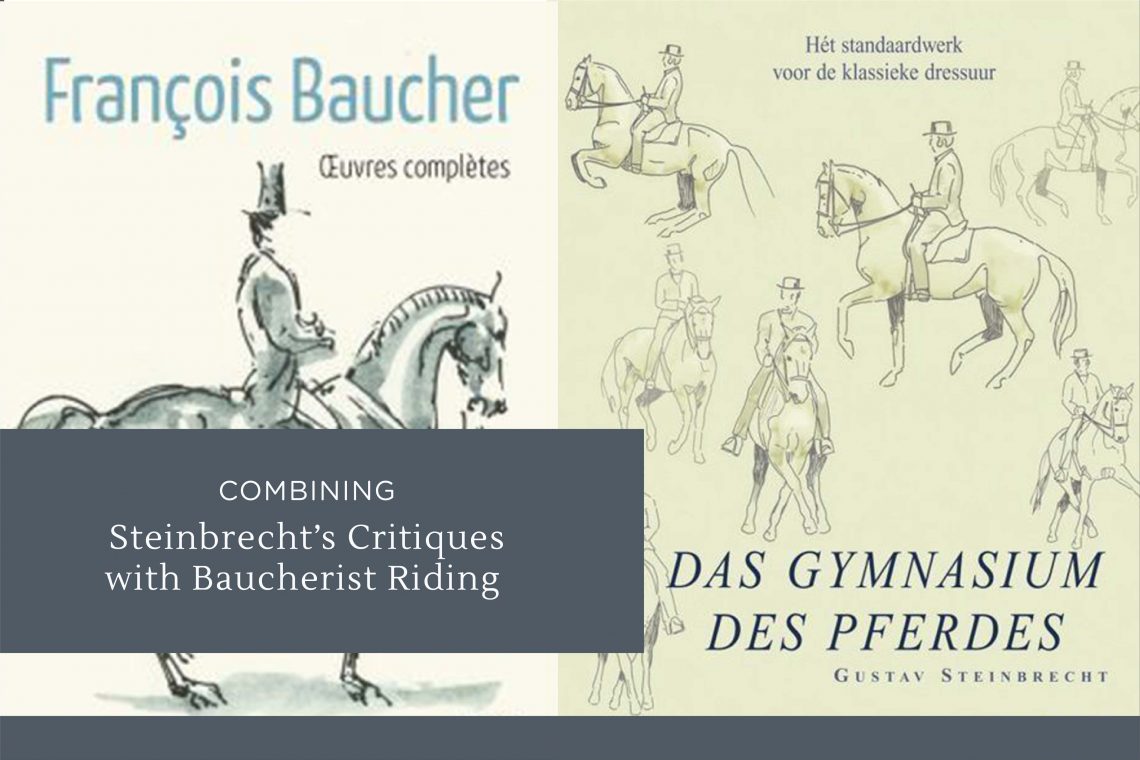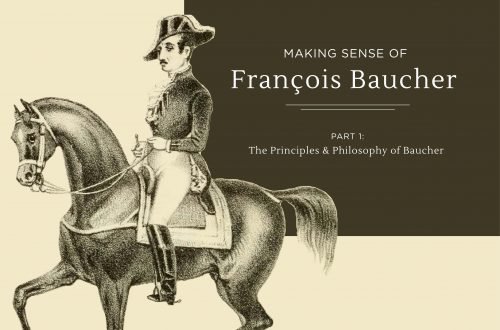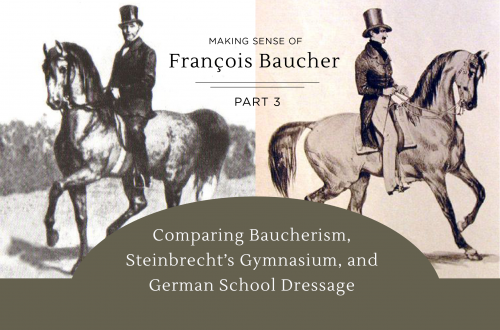
Combining Steinbrecht’s Critiques with Baucherist Riding
As an outspoken critic of François Baucher’s work, Gustav Steinbrecht described his critiques of Baucherism in his classic book, The Gymnasium of the Horse, as he advocated for following the training methods of the Old School. While both horsemen lived in the 19th century, Baucher and Steinbrecht had quite different approaches to training the horse – with Baucher seeking lightness and balance, and Steinbrecht seeking “throughness” and collectability.
Yet while Steinbrecht’s Gymnasium can sometimes be painted as if opposed to Baucherism, it can also be used effectively to complement Baucher’s methods. Master horsemen such as Nuno Oliveira have done just this, and shown that we can benefit from combining both methods. In particular, Steinbrecht’s critiques of Baucherism can be extremely useful if we use them to understand potential issues in training that Steinbrecht had observed, and design our training to prevent them.
Taking the best from both methods, we can benefit from the knowledge and experience of both horsemen.
Here, we’ll explore two of Steinbrecht’s greatest critiques of Baucherism, and how we can use them in Baucherist riding to develop lightness, balance and “throughness.”
Steinbrecht’s Critiques
Among Steinbrecht’s critiques of using Baucher’s methods, his most fundamental were that;
- The horse can develop a false bend if flexed only ever in the neck or flexed too far, which prevents the aids from passing through the whole body of the horse. This can put the horse behind the bit and on the shoulders. In part as a result of this;
- The horse may not develop enough impulsion, and so may perform movements without sufficient energy.
First, we’ll look at the issue of developing a false bend.
Bending, flexions, and flexibility of the neck
Baucher teaches us that attaining flexibility of the neck and relaxation of the jaw can be key to attaining lightness and balance. He writes;
“We know the contraction of any one part of the horse reacts on the neck, and that the stiffness of this part prevents the proper execution of every movement.”
“The equilibrium of the whole body is perfect, its lightness complete, when the head and neck remain of themselves easy, pliable and graceful. On the contrary, there can be no elegance, no ease of the whole, when these two parts are stiff.”
François Baucher, New Method of Horsemanship, 9th edition
Thus, we can use his flexions with the horse at a halt to release resistances and increase flexibility especially in the neck (though also in the hindquarters) to bring the horse into greater lightness and balance.
As with Baucher, Steinbrecht also focused intently on developing flexibility. However, he went about it in a slightly different way.
Steinbrecht put more emphasis on suppling the horse’s entire body primarily through careful bending exercises as the basis of all further training. This key bending work is done in motion to help develop the flexibility of all the joints, and so prepare the horse to begin to collect (eg. by flexing the joints of the hindlegs). He writes;
“The more this flexibility has been developed, without detriment to the thrust of the hind legs, the more perfect in every respect will be the training of the horse. All riders who consider it necessary at all to work the horse, therefore diligently try to remove any resistance in the throat-latch, neck, back, and hind legs, and they can often be seen bending and working these parts for hours.”
Gustav Steinbrecht, The Gymnasium of the Horse
The correct bend of the horse for these exercises, Steinbrecht explains, is one that extends through the entire spinal column, with a slight flexion in the ribcage, and that also bends the hind legs slightly. He explains;
“The lateral bending of the neck enables the horse to turn, to properly travel on curved lines, and to perform the movements on two tracks. Since this lateral bending of the neck is always connected with a correct, corresponding bend of the spine and of the hind legs, it simultaneously acts as a moderating effect on the thrust and prevents too heavy a contact.”
Gustav Steinbrecht, The Gymnasium of the Horse
This definition of a correct bend can also be very useful to a Baucherist rider seeking lightness. It tells us that with this bend through the whole body, where the hind legs are also flexed, this can very slightly shift the weight back and lighten the contact.
In comparing Baucher’s flexions and Steinbrecht’s bending work, we can see that Baucher focused on increasing flexibility in key areas – such as in parts of the neck – in order to unlock resistances throughout the rest of the body. Baucher performed his flexions at the halt, as he found resistances easier to release when they had no momentum. Working in this way allowed him to quickly improve the lightness and balance of any horse as he released resistances, such as those related to any natural asymmetry.
Steinbrecht, on the other hand, focused on gradually building flexibility throughout the whole body at once, and so used bending exercises with the horse worked in motion.
Now, while Baucher’s targeted method allowed him to increase flexibility, balance, and lightness very efficiently, what Steinbrecht observed is that practicing flexions only in the neck could also easily be overdone, leading to hyper flexibility and instability of the neck.
This, he found, could lead to a “false bend” if the horse is then consistently asked to flex too much in the neck when in motion, without the corresponding bend in the entire spinal column and hind legs. This creates a tendency for the forward and restraining aids to become “trapped” in the false bend, causing the horse to go behind the bit, and onto the shoulders.
This, in essence, is Steinbrecht’s first critique of Baucher’s work.
Steinbrecht found that Baucherized horses could become too flexible in the neck, by being flexed only ever in the neck and not through the body, and flexed too far, to the point where the stability of the neck would be lost. With this, the ability to drive the hindquarters towards and underneath the neck would also be lost, which would then limit the horse’s ability to develop impulsion. He explains;
“As necessary as a flexible and agile neck is for the fully trained horse, it must also be connected with perfect steadiness. This is so because for every bend and position of the neck, the joining surfaces of its vertebrae must remain sufficiently in contact to thus be able to transmit the driving as well as the restraining aids. If, however, the neck is bent too much at individual points so that the area of contact between the vertebrae in question becomes too small, a false bend appears at which the rein action from the hands as well as the driving aids are broken; to use the customary term, the aids are stuck in the incorrect bend. This produces the most dangerous type of “being behind the bit” in the horse since now the rider is no longer able to correctly hold the weight and work the hindquarters against it or drive them underneath it.”
Gustav Steinbrecht, The Gymnasium of the Horse
Nuno Oliveira, who combined both systems also echoes Steinbrecht in describing the importance of maintaining some stability in the neck once it has been suppled, in saying;
“The horse may not be called submissive, nor in forward action, if the base of the neck is not in a stable position or if the neck is too yielding, flinching from the contact of the bit and the action of the reins.”
Nuno Oliveira, Reflections on Equestrian Art
So how can we combine the best of Steinbrecht’s and Baucher’s systems?
It seems it’s about using each in slightly different circumstances to achieve different things.
Baucher’s flexions at the halt are incredibly useful when our goal is to;
- Efficiently increase the horse’s flexibility (especially in the beginning of training),
- Enable the horse to become light in hand, or to;
- Release specific areas of resistance especially in the neck, jaw, and throatlatch that are related to a horse’s natural asymmetry, in order to bring it into better balance throughout training.
Because Baucher’s flexions are quite efficient and targeted, we can use them when there is a specific area of resistance to release, or to increase the horse’s flexibility to prepare it for working in lightness. Then, once sufficient flexibility has been achieved, we can take care not to flex the neck laterally too much so it maintains enough stability. These flexions are very efficiently used, as Baucher suggests, with the horse at a halt.
However, when we work the horse in motion, bending the horse through its entire body as Steinbrecht describes can then allow us to better flex the hind legs and enable collection. This also prevents a false bend from occurring, and so keeps the horse from falling onto the shoulders and becoming behind the aids.
A key to achieving this proper bending is in attaining sufficient ribcage flexion. Using the inside leg to flex the ribcage and guide the inside hind leg slightly under the horse, we can then use well-timed half-halts on the outside rein to lift the outside shoulder if it becomes overloaded, to transfer weight back to the inside hind leg. Taking care that during bending work, the horse is bent through its whole body further ensures the horse’s lightness and balance as it shifts the weight back slightly onto correspondingly bent hindlegs.
Thus, Steinbrecht’s comments on developing a false bend can be incredibly helpful to understand the importance of both flexibility and stability in the neck, and so help the horse become both light and “through,” as the aids can move freely through the horse.
This brings us to Steinbrecht’s second criticism which, as we will see, is closely related to the first.
Creating sufficient impulsion
Perhaps Steinbrecht’s most often-cited criticism of Baucher’s work was that his methods did not encourage enough impulsion.
Steinbrecht had two main reasons for this criticism. The first reason relates again to maintaining enough stability in the neck. Without enough stability, he explains, it then becomes very difficult to drive the hindquarters towards and underneath the forehand, which limits impulsion. He describes this by writing the following about Baucher;
“He suppresses and destroys thrust not by overloading, as this is done by careless riders, but prevents its action by removing everything against which it could be directed.”
Gustav Steinbrecht, The Gymnasium of the Horse
By this Steinbrecht means that by making the neck too soft and flexible, one removes the necessary stability in the neck, “against which” thrust can be directed. Impulsion then becomes more difficult to develop because it becomes harder to reliably build and channel it forward from the hindquarters to the forehand, connecting the horse together.
If the horse doesn’t develop enough impulsion, and the stability of the neck is also lost, the horse can then become like a snake, and feel as though the hindquarters and forehand are disconnected. As Steinbrecht observed, the horse may then perform movements without enough energy because the necessary impulsion cannot be built up and directed to the forehand.
Steinbrecht’s second reason for his criticism was that Baucher worked extensively in place and at a walk, which Steinbrecht found did not develop enough impulsion.
Nonetheless, there is also great value in working this way, as Baucher realized.
Baucher explains that, at the halt or the walk, it is much easier and more efficient to target specific areas to work, or to release resistances. This is because issues stemming from problem areas tend to gain momentum and become more difficult to resolve when the horse is set in motion.
Baucher also realized that a horse’s movement is determined by its component parts – and if those parts are in a position that would make a movement difficult (by being asymmetrical, or having the weight in the wrong place, for example), it is in those parts that the sources of the issues are found and must be fixed, rather than in the movements they lead to. He explains;
“A horse puts himself in motion only in consequence of a given position; if his forces are such as to oppose themselves to this position, they must first be annulled, in order to replace them by the only ones which can lead to it.”
François Baucher, New Method of Horsemanship, 9th edition
Thus, Baucher found it much easier and faster to improve the movement of a horse by ensuring its proper position, through releasing the resistances that could prevent the horse from easily taking a certain position corresponding to a certain movement.
Because Baucher found that it was key to establish the “position before movement,” he worked mainly at the halt or at the walk where, without momentum, he found it easier and faster to release the necessary contractions.
Thus, while working in place or at the walk may not develop as much impulsion as faster gaits, it can be a much quicker and more precise method of solving many problems related to asymmetry, stiffness, or weakness.
As an interesting aside, Steinbrecht instead advocated for and found that it was easier to influence the horse to take a better position when in motion, when fewer feet are on the ground such as in the trot or canter. He writes;
“…it is much more difficult to obtain the correct body position in place since the horse, resting on all four legs, has it much easier to relieve one of the legs in an incorrect way than, for example, at the trot, where it must balance itself on alternating two legs and is thus forced to keep its body more in balance in any case.”
Gustav Steinbrecht, The Gymnasium of the Horse
So, how do we balance the precision and efficiency of working in walk or at the halt, with developing impulsion in faster gaits?
Once again, it comes down to using a method depending on what we are aiming to achieve at a certain point in time, and what the horse needs.
If we notice a particular point of resistance, wish to make the horse react more precisely, or carry itself with greater lightness, working at a walk or halt can help to improve things very efficiently.
Then, if we notice the neck becoming too unsteady, or the forehand feeling as though it were disconnected from the hind end, we can work more in free gaits such as the trot. For example, practicing shoulder-in at the trot can help to work the hind legs, ensure the horse goes forward, and develop flexion throughout the whole body to help reconnect the forehand and hindquarters.
By alternating between the methods as needed, we can find that the flexions and bends the horse assumes then become more “true,” as the neck becomes both steady and flexible, and the horse becomes both light and stable in the hands. With the forehand and hindquarters kept connected, the horse becomes more “through,” and better able to develop sufficient impulsion.
The Key Takeaway
While Steinbrecht and Baucher approached their horsemanship from quite different angles – and these angles have sometimes been interpreted as being opposed – both of their ideas and methods can be extremely useful. By studying both methods, and particularly taking care to understand Steinbrecht’s critiques, we can more fully understand different ways to influence and benefit the horse, for what situations we can use each method, and most importantly – why.
Baucher took a much more focused, efficient approach to creating lightness and balance through releasing key contractions. His method can be very useful for rapidly improving flexibility, balance and lightness.
Steinbrecht on the other hand, took a much more general, gradual approach to creating collectability and “throughness” through working the whole horse all at once in motion. His method can be very useful for increasing collectability, “throughness,” and impulsion.
Using both methods as needed to prevent and work through issues that come up in training can help us benefit from the strengths of both methods, and help our horses develop both in lightness and balance, as well as with “throughness” and collectability.




